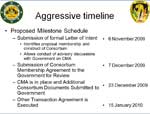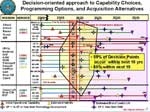The Administration Proposes a New Model for the Vertical Lift Industry: Shaping a Way Ahead on Research and Development

Vertical Lift Aviation Industry Day, slide 13
[Download the Complete Presentation as a PDF]
The initiative is designed to re-organize the scattered Research and Development money within the DOD budget for vertical lift platforms, and to provide a central clearing point for shaping the way forward for the industry and the government. According to the key government speaker at the industry day, “for the purposes of this meeting, the US Vertical Lift Aviation Private Sector is defined as: US companies, including US companies under foreign ownership, control or influence (FOCI), that are both ‘FOCI-mitigated’ and possess a facility clearance level (FCL) for the appropriate classification.“

Vertical Lift Aviation Industry Day, slide 19
According to the briefing provided by Mike Walsh from the Office of the Secretary of Defense (A, T and L), there is a steady if not growing demand for rotorcraft, and yet industry faces an uncertain future. For industry, production programs end about 2018-2020, which will lead to eroding infrastructure and engineering expertise and with limited R and D alternatives for transformation opportunities, new business, or technology upgrades. The briefing in particular underlines the upcoming shortages of skilled workers in the aerospace sector:
-
“Aerospace industries face acute shortages of skilled workers in the future
-
No active US rotorcraft RDT&E after Apache Bik III and Ch-53K
-
Talent at home will be shrinking – but will be expanding globally
– Void in experience & knowledge
– Qualified labor will be in high demand and hard to attract
– Most future post graduate students will be overseas -
Global industry trends will impact defense contractors and their supply chains”
This can only be fixed by shaping a new approach to government and industry working together. And Walsh underscored that absent government investment, and a clear path towards government investment, industry would not invest as well. Or as Walsh’s presentation put it: “major industry initiatives were unlikely without DOD investment.”
Vertical Lift Aviation Industry Day, slide 23
Indeed, one of the more refreshing aspects of the Walsh presentation was a very clear recognition of the impact of lack of clarity in government acquisition upon industrial development. His presentation had a fascinating slide entitled “Decision-oriented approach to Capability Choices, Programming Options, and Acquisition Alternatives” which nicely captured the crossover impact of government acquisition decisions upon industrial development.
The problem or challenge was clearly identified: the need to shape a more effective partnership between industry and the government to delivery the capability which the services need from rotorcraft. To do so, OSD is proposing to do the following:
- “Establish a formal, long-term (~20 year) mechanism to facilitate teaming, networking, planning, and technology development;
- For the Government: OSD-led; broad membership including all Services and cognizant functional organizations; open to NASA and the Coast Guard;
- For Industry: an open consortium including traditional rotary wing industry, non-traditional contractors, academia, and associations;
- For the Nation: a forum to establish U.S. leadership in the advancement of vertical lift technologies, and in the development and production of vertical lift aircraft;
- How: by establishing a simple contracting relationship with a single U.S. consortium using 10 USC 2371, Other Transaction Authority.”
At the heart of the government’s proposal is to establish a mechanism for coordinating the Research and Development money, which would go to industry. Currently, there are multiple S and T plans affecting rotorcraft, administered by the services, multiple government labs and multiple outlet agencies, including DARPA. This creates a situation where there are multiple requirements with very little money, for approximately the $110 million in rotorcraft S and T becomes fractionated across an organizational maze. And much of this pays for S and infrastructure rather than real research. If the government through the consortia approach can corral the S and T money and channel to real research, this would be a major plus.
But the challenge will be precisely to both establish a central clearing point AND control the money. If this does not happen, the approach will not succeed. An OTA or Other Transaction Authority will govern the consortia rather than by the Federal Acquisition Regulations (FAR), so contracts would be negotiated on a case-by-case basis. The Intellectual Property (IP) of the companies could then be protected on a case-by-case basis.
If this approach works, the consortia could set in motion a process, which could play the role of a forcing function for the industrial base. And the government would also be seeking a way around the FAR sanctioned protest process. OTAs are not subject tot eh FAR and therefore not subject to protest. The consortia approach is clearly designed to try to reduce the paralyzing impact of the protest process on acquisition policy.

Vertical Lift Contracting Overview, slide 6 [See PDF]
The government hopes to move rapidly on this approach. The presentation on the contracting authority clearly laid out how rapidly the government wished to go, with dealines set for Decmber 7th, 2009 for the submission of a Consortium Membership Agreement to the Government for Review and a CMA in place by the 23rd.
———-
***Posted November 16th, 2009


